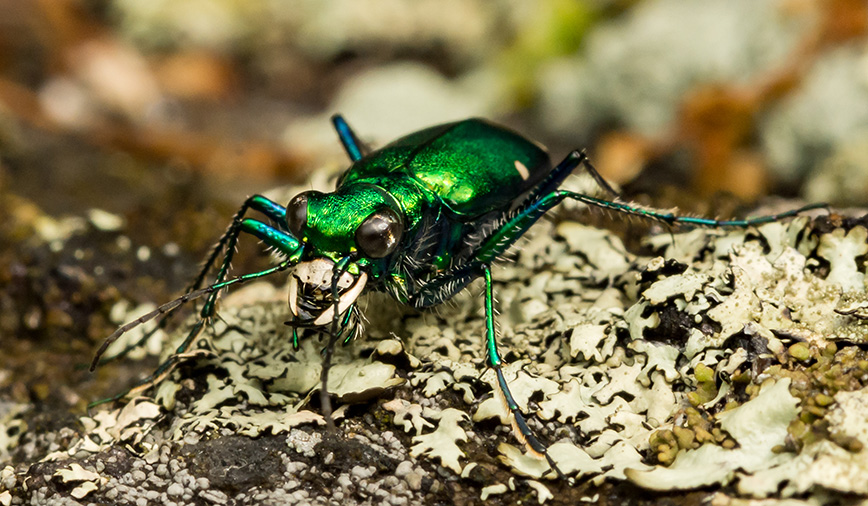Pam’s Perspective
From the…
Pam Otto is the Manager of Natural Programs and
Interpretive Services for the St. Charles Park District
May 17, 2013
I’ve never, by any stretch of the imagination, been considered quick. I can’t dash, I don’t
dart. In fact, the only time I recall moving with any speed at all was once when I was
being chased by a horde of angry wasps.
A flat-out sprint, and they still got me.
Given that track record, it’s only fitting that much of the wildlife I know best is, well,
slow. Snails, for example. We all know what pace they move at. And freshwater mussels,
bless their little two-chambered hearts; they make snails seem like speeding maniacs.
So imagine my delight when, amid last week’s rain and cool temperatures, I stumbled
on an insect that usually far exceeds my capacity to keep up: the six-spotted tiger
beetle.
Several of these normally fast-as-lightning insects had taken refuge from the weather by
retreating into burrows in the clay-ey piles of shale we have arranged in the Hickory
Knolls Natural Area. All would have been well for the beetles, except that the shale piles
were there for 375 Haines Middle School geology students to dig through in search of
fossils.
Besides unearthing Ordovician brachiopods and
bryozoans, the kids also brought up several chilled
tigers. The beetles, awakened from their semi-
torpid state, seemed dazed, and confused. And
slow.
What was not-so-great luck for the tiger beetles turned out to be a very fortunate
occurrence for me and the students in my field-trip group.
Tiger beetles are about as close to winged gems as you’ll ever find here in Kane County.
Their elytra, or leathery wing covers, are a bright, metallic-looking green. The six spots in
their name can be present or absent, or range up to as many as 12, and are whitish in
color.
Stylish too, these beetles sport white mandibles that match their spots and are
characteristic traits—that is, they are present even if the spots are not. It’s these strong,
overlapping mandibles, or jaws, that allow the insects to fulfill their important ecological
niche.
Six-spotted tiger beetles, and their many tiger beetle cousins, are predators that
consume a wide variety of arthropods. Ants, moths, spiders, even other beetles can’t
escape the tenacious tigers, which snatch their quarries both on the ground and in the
air.
Their larvae, though less mobile, are equally voracious. Lacking wings, they hang out at
their burrow openings, waiting for unsuspecting prey to come ambling along. When a
meal comes within range they pop up, seize the hapless creature, then retreat to dine in
the relative safety of their tube-like homes.
Adult six-spotted tiger beetles are an undeniable part of woodland walks in early
summer. Though they’re only about a half inch in length, their brilliant colors and quick
movements make them hard to miss.
Look for the beetles on trails in or near wooded areas. They can be found on the ground
as well as on objects such as rocks or logs. One moment they are perfectly still, the next
they are turning one way or another, always orienting toward movements they
perceive.
This wariness actually serves a dual purpose. Besides scoping out the landscape for
potential prey, tiger beetles also have to make sure they do not become prey
themselves. Fierce though they may be, and despite a distasteful chemical defense, tiger
beetles are preyed upon by birds, as well as other insects like dragonflies and robber
flies.
The weather forecast calls for warm temperatures and mostly sunny skies over these
next few days, conditions that are ideal for stalking tiger beetles. If you’d like to try and
spot some for yourself, head out for a walk in the woods. When you see a beetle up
ahead, slow down and try to keep your shadow behind you. If the insect startles and
flees, follow it with your eyes; these territorial tigers rarely fly far and will often end up
circling back after only a few minutes’ time.
Or…you could wait for the next cold, rainy day, and head for the shale piles at Hickory
Knolls. If your timing’s right, you may run into a busload of sixth graders armed with
trowels, or maybe a slow, lumbering naturalist, to help you with your hunt.
Pam Otto is the manager of nature programs and interpretive services for the Hickory
Knolls Discovery Center, a facility of the St. Charles Park District. She can be reached at
630-513-4346 or potto@stcparks.org.

